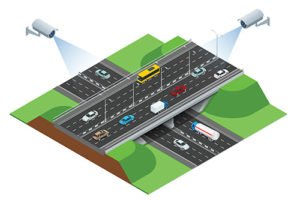These systems are a one- stop solution to overcome traffic management issues like, collision / accidents, traffic congestions, parking in public places, quick and efficient toll booth operations, just to name a few. Conjunctively, Video analytics and AI based ITMS are technologically adept solutions having highly nimble and agile system with extremely sophisticated functions like:
• Vehicle / Pedestrian detection: It helps in differentiating between pedestrians & vehicles. This may prove helpful in pedestrian safety. It can give an approximate count of total number of vehicles & pedestrians on the road. This can also be used as an input for other smart city initiatives.
• Vehicle classification: It helps in detecting the type of vehicle – Truck, Bus, Taxis etc.
• Evidence in case of Accidents: Video surveillance with analytics enables us to gather evidence in case of accidents, which proves to be helpful in protection against litigation and provides evidence for insurance processing.
• Congestion detection: Video analytics helps to detect the velocity of traffic, whether the traffic is moving at slow rate or fast or halted. • Stopped vehicle detection: The video based automatic vehicle detection help to detect the vehicles parked in a nondesignated parking area like freeways.
• Wrong way vehicle detection: Detects & warns drivers and alerts authorities, thereby preventing accidents and improving roadway safety. When the driver tries to take a wrong turn, the system triggers a red LED message to the driver, warning him/her to stop & turn around. Also, it can send a text or email alert to designated responders to deploy & attempt to stop the vehicle if they continue to pass the sign.
• License plate recognition: This is another feature used to identify & read license plate numbers for logging in all the data related to the vehicle, which can then be used for toll, traffic control, suspicious activities detection, etc.
 Providing real-time, meaningful & actionable data
Providing real-time, meaningful & actionable data
Intelligent traffic cameras provide real-time, meaningful, and actionable data to Traffic Control Centers. This allows for better understanding of traffic patterns and counts including assessing peak and non-peak periods at a glance. It gives the insight into where and when officers are most needed. It also provides a better understanding of driver behaviour including when people speed and what speeds are typical. Ultimately,the cameras transform the transportation ecosystem by helping to change those behaviors. Real time alerts and warnings to slow down by SMS, email, and mailings give drivers an impetus to slow down or suffer the consequences.
The technology used by traffic cameras essentially allows for police presence on the roads 24/7.
IoT & big data is being used by developed countries to their advantage thereby, minimizing the issues and threats related to traffic. Video Analytics can also play an important role in getting insight of the daily traffic, and these data can help in curbing congestions by routing the information to the traffic management console.
 Ahuva Basch, Head of Engineering, Logix ITS, said, “While speed cameras used to be more controversial, many law enforcement agencies across India are changing their perception and approach to cameras technologies. As they see the need for change to stop the epidemic of road injuries and deaths, they have become more open to using technology to keep people safe on India’s roads. In addition, the market in India is very price sensitive and while our solutions are very competitively priced, some buyers are willing to forfeit quality and accuracy simply for a better price tag. This is a challenge in speed enforcement since trust is the cornerstone to automated ticketing. If carmeras aren’t accurate or ethically implemented, trust is lost, and the program cannot succeed.
Ahuva Basch, Head of Engineering, Logix ITS, said, “While speed cameras used to be more controversial, many law enforcement agencies across India are changing their perception and approach to cameras technologies. As they see the need for change to stop the epidemic of road injuries and deaths, they have become more open to using technology to keep people safe on India’s roads. In addition, the market in India is very price sensitive and while our solutions are very competitively priced, some buyers are willing to forfeit quality and accuracy simply for a better price tag. This is a challenge in speed enforcement since trust is the cornerstone to automated ticketing. If carmeras aren’t accurate or ethically implemented, trust is lost, and the program cannot succeed.
“While our system is extremely intuitive and simple to use, there is always some legwork involved when integrating with other systems. Our API is easily integrated with a host of other ITS systems and we have a dedicated customer service team to help with any challenges and assure a smooth program rollout. Our solutions work with remote and wireless communication, which makes integration easier than with systems that require ethernet or other infrastructure adjustments. The reliability of power grids and local infrastructure is also a factor to consider when integrating multiple systems.
 “We have had very positive feedback about how quickly the cameras can be integrated and up and running. In Kolkata alone, we have issued over two million tickets. The city has been very impressed with the accuracy and consistency of our systems.”
“We have had very positive feedback about how quickly the cameras can be integrated and up and running. In Kolkata alone, we have issued over two million tickets. The city has been very impressed with the accuracy and consistency of our systems.”
Companies are now looking to integrate various pieces of Intelligent Traffic Solutions through Internet of Things and elevate transportation network to the next level — where commuters have access to more information, transportation networks are more interoperable and monitoring traffic movements is easier for authorities.
Preeti Swaminathan
 TrafficInfraTech Magazine Linking People Places & Progress
TrafficInfraTech Magazine Linking People Places & Progress